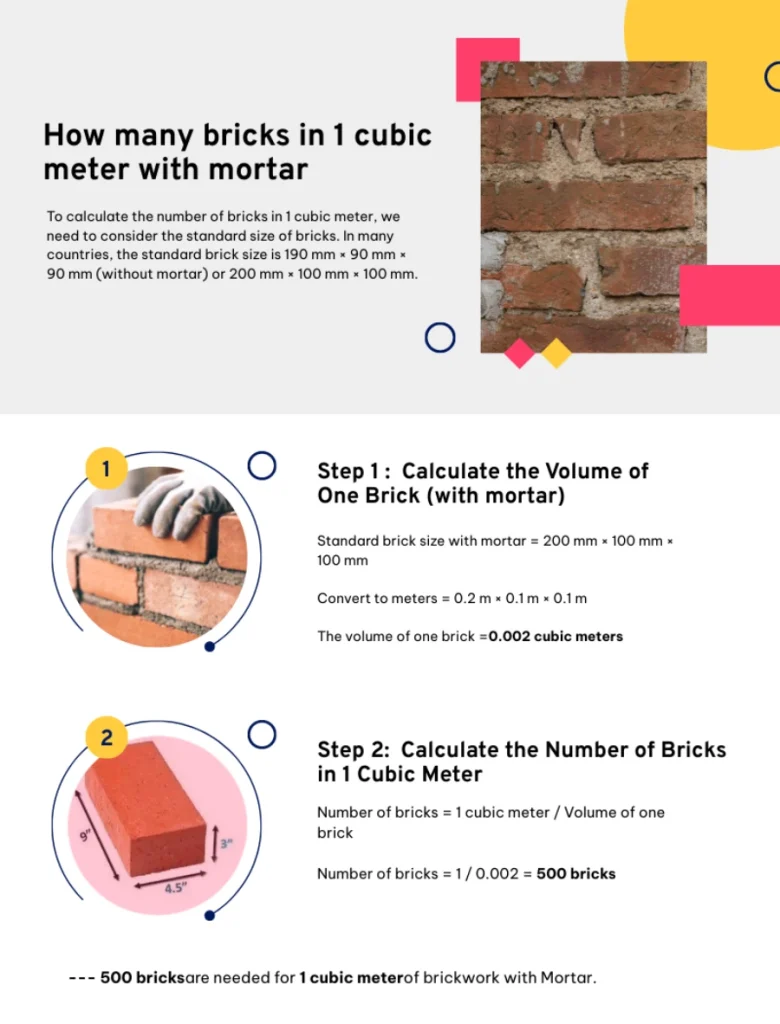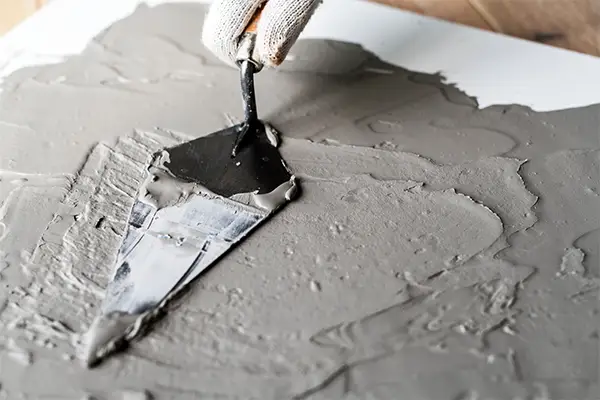The fundamental construction element is concrete, a versatile material that shapes the built environment around us. Knowing concrete components is crucial when you are building your dream home. Cement is an essential component of the concrete mix, and getting the right amount is essential to building a sturdy and long-lasting structure. This blog explores how many bags of cement are required for one cubic meter of construction and the factors affecting the amount of cement required. But before we start to learn in detail, let’s understand what cement is and its importance.
How Many Bags of Cement Required for One Cubic Meter

To calculate the cement bags required for one cubic meter, you have to consider the concrete mix design ratio for your construction. The concrete mix design ratio is the ratio of water, cement, sand, and aggregate in a concrete mix. The strength, workability, and durability of your building are all directly impacted by this ratio. Hence, selecting the proper proportion for concrete mixing is essential to guarantee that your building will be strong and durable.
Calculation of how many bags of cement to make 1m3 of concrete 1:2:4
To calculate the cement requirement per cubic meter construction, you must find out the total volume of cement and the volume of 1 bag of cement.
So, for the cement volume calculation, let’s assume your concrete design mix ratio is 1:2:4, which means that 1 part is cement, 2 parts are sand, and 4 parts are aggregates. Along with the precise ratio, also consider the loss of cement as cement’s particles are too small. Hence, there is a high chance of losing it. So, assume a 2% of cement loss.
If you assume that the output of the mix is 67%, then the required dry mix to achieve 1 cubic meter output is-
1/Total output of the mix
=1/0.67
=1.49 round figure 1.50 cubic meter dry mix.
Now, you also need to add cement wastage to it. So, wastage is 2%,
So, total dry mix + 2% wastage
=1.50+0.02
= 1.52 cubic meters.
Now, you have to calculate the total volume of cement,
= Volume of cement = Total material × (cement/cement+sand+aggregate)
= 1.52 × (1/1+2+4)
= 0.2171 cum
Now, the standard weight of 1 bag of cement is 50 kg, and the density of cement is 1440 kg/cubic meter.
Therefore, the volume of 1 bag of cement,
= 50/1440
=0.0347 cum.
Hence, no. of cement bags required for 1 cubic meter of construction is,
= Total volume of cement/ volume of 1 bag of cement
= 0.2171/0.0347
= 6.25 bags.
So, the number of bags of cement required per cubic meter of 1:2:4 concrete will be approximately 6.25 cement bags.
How many bags of cement to make 1m3 of concrete 1:2:3
To calculate the number of bags of cement needed to make 1m³ of concrete with a mix ratio of 1:2:3 (cement:sand:aggregate), follow these steps:
Step 1: Understand the mix ratio
The ratio 1:2:3 means that for every 1 part of cement, you need 2 parts of sand and 3 parts of aggregate (gravel or crushed stone).
Step 2: Calculate the total parts in the mix
Total parts = 1 (cement) + 2 (sand) + 3 (aggregate) = 6 parts.
Step 3: Determine the volume of cement in the mix
Cement occupies 1/6th of the total volume because it is 1 part out of 6 parts. Volume of cement = 1m³ ÷ 6 = 0.167m³ (cement).
Step 4: Convert cement volume to weight
The density of cement is approximately 1440 kg/m³.
Weight of cement = 0.167m³ × 1440 kg/m³ = 240.48 kg.
Step 5: Calculate the number of bags of cement
Cement bags typically weigh 50 kg each.
Number of bags = 240.48 kg ÷ 50 kg/bag = 4.81 bags.
You would need approximately 5 bags of cement to make 1m³ of concrete with a 1:2:3 mix ratio.
Cement required for 1 cubic meter of brickwork 1:6
To calculate the cement required for 1 cubic meter of brickwork with a mix ratio of 1:6 (cement: sand), follow these steps:
Step 1: Understand the mix ratio
The ratio 1:6 means for every 1 part of cement, there are 6 parts of sand.
Step 2: Calculate the total parts in the mix
Total parts = 1 (cement) + 6 (sand) = 7 parts.
Step 3: Calculate the volume of cement in the mix
The volume of cement is 1/7th of the total volume, as cement makes up 1 part out of 7. Volume of cement = 1m³ ÷ 7 = 0.143m³ (cement).
Step 4: Convert the volume of cement to weight
The density of cement is around 1440 kg/m³.
Weight of cement = 0.143m³ × 1440 kg/m³ = 205.92 kg.
Step 5: Calculate the number of bags of cement
Each bag of cement weighs 50 kg.
Number of bags = 205.92 kg ÷ 50 kg/bag = 4.12 bags.
How many bags of cement to make 1m3 of concrete 1:3:6
Step-by-step breakdown of how many bags of cement to make 1m3 of concrete 1:3:6:
The mix ratio 1:3:6 means:
1 part cement
2 parts sand (fine aggregate)
6 parts coarse aggregate
This is a nominal mix, and the total parts = 1 + 3 + 6 = 10 parts
Step 1: Dry Volume of Concrete
Concrete expands when mixed, so we consider a dry volume = wet volume × 1.54
Dry volume = 1 × 1.54 = 1.54 m³
Step 2: Cement Volume in the Mix
Cement’s share = 1/10 of the dry volume
Cement volume = 1/10 * 1.54 = 0.154m3
Step 3: Convert Cement Volume to Bags
The volume of 1 bag of cement (50 kg) = 0.035 m³
A number of bags = 0.154/0.035 ≈ 4.4 Bags.
You’ll need approx. 4.4 bags of cement for 1m³ of concrete (1:3:6 mix)
How many bricks in 1 cubic meter with mortar

To calculate the number of bricks in 1 cubic meter, we need to consider the standard size of bricks. In many countries, the standard brick size is 190 mm × 90 mm × 90 mm (without mortar) or 200 mm × 100 mm × 100 mm.
Step 1: Calculate the Volume of One Brick (with mortar)
Standard brick size with mortar = 200 mm × 100 mm × 100 mm
Convert to meters = 0.2 m × 0.1 m × 0.1 m
The volume of one brick = 0.002 cubic meters
Step 2: Calculate the Number of Bricks in 1 Cubic Meter
Number of bricks = 1 cubic meter / Volume of one brick
Number of bricks = 1 / 0.002 = 500 bricks
500 bricks are needed for 1 cubic meter of brickwork with Mortar.
The calculation for cement required for 1 cubic meter of brickwork 1:4
To calculate the cement required for 1 cubic meter of brickwork with a mix ratio of 1:4 (1 part cement and 4 parts sand), we’ll follow a similar approach:
Step 1: Understand the Mix Ratio
Mix ratio: 1:4 (1 part cement, 4 parts sand)
Total parts: 1 (cement) + 4 (sand) = 5 parts
Step 2: Calculate the Dry Volume of the Mortar
The volume of dry mortar is approximately 30% more than the wet volume of mortar. So for 1 cubic meter of brickwork, the dry volume of mortar required is:
- Dry volume of mortar: 1 cubic meter * 1.30 = 1.30 cubic meters
Step 3: Calculate the Cement Volume
The cement volume is calculated as:
Cement volume = (Dry volume×Cement part)/Total parts
Cement volume = (1.30×1)/5=0.26 cubic meters
Step 4: Consider Cement Wastage
Assume 2% wastage for cement, so the effective volume of cement needed:
Total cement volume = 0.26 cubic meters×1.02 = 0.2652 cubic meters.
Step 5: Calculate the Number of Cement Bags
The volume of one bag of cement (50 kg) is calculated as:
Volume of 1 bag of cement (in Cubic Meters) = 50 kg/1440 kg = 0.0347 cubic meters
Now, calculate the number of cement bags required:
Number of cement bags (in cubic meters) =0.2652/0.0347 = 7.64 cubic meters/bag.
So, the cement bags required for 1 cubic meter of brickwork 1:4 is 7.64 Bags.

The following factors influence the requirement for cement.
1. Concrete Mix Design Ratio:
The requirement for cement varies depending on the concrete mix design ratio means 1:2:3 or 1:1.5:3 or 1:2:4, etc. If you want stronger concrete, it typically requires a higher cement content.
2. Water-Cement Ratio:
The workability and strength of the concrete depend on maintaining a proper water-cement ratio. To maintain workability, you have to increase the water-cement ratio, which influences the cement requirement.
3. Aggregate Size and Type:
The size and type of aggregates affect the interparticle space, affecting the total volume of the concrete and, ultimately, the requirements of the cement.
4. Concrete Strength:
The amount of cement used in a concrete depends on its intended strength. You need more cement for high-strength concrete mixes than lower-strength ones.
Plastering calculation in sqm (Square Meters)
When calculating plastering for a construction project, it’s crucial to account for both the surface area to be plastered and any features that may alter the plastering requirements, such as windows and doors. Here’s the step-by-step process:
Measure the Surface Area (Walls and Ceilings)
Walls:
- Measure the height and length of each wall.
- Multiply the height by the length to get the surface area of each wall.
- Formula:
- Area of Wall = Height × Length
- Area of Wall = Height × Length
- Ceilings (if applicable):
- Measure the length and width of the ceiling and multiply them for the area.
- Formula:
- Area of Ceiling = Length × Width
Subtract Openings (Windows, Doors, etc.)
Windows & Doors:
- Measure the height and width of each window and door.
- Multiply the height by the width to get the surface area of each opening.
- Formula:
- Area of Opening=Height×Width
- Area of Opening=Height×Width
- Subtract the total area of all openings from the total wall area.
Total Surface Area for Plastering
- After subtracting the openings, you’ll get the total area to be plastered.
- Formula:
- Plastering Area = (Total Wall Area+Ceiling Area) − Total Opening Area
Add Extra for Corners and Ridges (if applicable)
- In some cases, the plastering may require extra work around corners or ridges.
- You can estimate the additional area based on the perimeter of the walls or the number of corners and edges.
- If there are decorative features or complex designs, these areas should be considered as well.
- You can estimate the additional area based on the perimeter of the walls or the number of corners and edges.
Thickness of the Plastering
- Plastering thickness affects the volume calculation and material estimation.
- Standard plaster thickness is usually 12mm for walls and 15mm for ceilings.
- You can calculate the volume of plaster by multiplying the surface area by the plaster thickness:
- Volume of Plaster = Area of Surface × Thickness of Plaster
- Volume of Plaster = Area of Surface × Thickness of Plaster
Material Calculation
- Cement and Sand Mix Ratio:
- The plaster mix is usually in a ratio like 1:4 (Cement: Sand), depending on the type of plastering required (e.g., smooth finish or rough).
- The mix ratio affects the quantity of materials (cement and sand) needed.
- The plaster mix is usually in a ratio like 1:4 (Cement: Sand), depending on the type of plastering required (e.g., smooth finish or rough).
- Estimating Cement:
- Based on the thickness of the plaster and the ratio, you can estimate how much cement is required per square meter.
- Typically, 1m² of plastering requires approximately 0.02 to 0.025 cubic meters of plaster mix, depending on the thickness and type of plastering.
- Based on the thickness of the plaster and the ratio, you can estimate how much cement is required per square meter.
Importance of the Material Estimation
For the best construction quality and precise budget planning, it is imperative to know how to estimate the construction cost and quantity of material, as the material cost is 60% of the total construction cost. Your build-up area indicates the amount of materials needed for construction, and the costs may differ depending on the contractors and their location. For instance, compared to the internal material supply chain of a reputed construction company like Brick&Bolt, buying cement from regional suppliers through regional contractors might be more expensive.
Conclusion
On a final note, the amount of bags of cement required for one cubic meter of concrete depends on several factors, including the mix ratio, the desired strength, and the properties of the aggregate. It is important to ensure that the final concrete meets structural specifications to achieve an effective balance between strength and cost. Always adhere to industry norms and regulations to get the best possible outcomes for your dream construction project.

